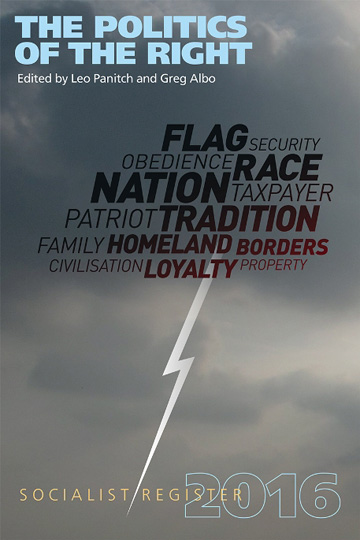
With its 2016 edition, “The Politics of the Right,” the Socialist Register has once again demonstrated why, after 52 years, it remains one of the premier international academic journals of the left. This year’s issue brings together a collection of nineteen essays by scholars from around the world engaging with the pivotal challenges presented by the advance of the political right on every continent. For American readers facing record turnout numbers for Donald Trump during the primaries, the growth of billionaire-funded “grassroots” organizations, and the resurgence of racist extremism, this focus on the right danger and its connection to international trends is especially timely.
Although the authors in the volume cover very diverse ground and vastly different political contexts – from Europe to Africa, Asia to the Middle East, and spanning both American continents – there is a unity of focus that draws all their pieces together. As the editors, Leo Panitch and Greg Albo, say in their preface, this year’s Register is a “careful political mapping of the new right,” dealing with the questions of its social base, organizational strength, influence in mainstream politics, and the extent to which it is already penetrating the state. For each of their respective countries or regions, the contributors seek to do just this.
Liz Fekete, for instance, traces the way in which overlapping ideological commitments are drawing together “ultra-patriot” far-right movements and centrist politicians in large swathes of Europe, as they converge on hyped-up fears of refugees, the denial of welfare services to immigrants, resistance to multiculturalism, and devotion to a system of law-and-order supposedly under threat.
Many of the authors draw a connection between these types of phenomena and the deterioration of democracy under the conditions of an ongoing neoliberal crisis. Geoff Eley, a historian of classical fascism and Germany, makes the point abundantly clear when he states, “As a practice of citizenship and participatory identification with a system of governance, democracy is becoming dangerously hollowed out.” The onset of the financial crisis of 2008 and the incoherent response to it allowed “a politics that begins to look like fascism” to coalesce. Though 2008 and its aftermath, as Eley says, have really just been a further aggravation of the dislocation and uncertainty that has been the norm for millions since the beginning of capitalism’s restructuring in the 1970s.
One condition allowing twentieth century fascism to prosper, as Eley points out, was the incapacity of the state to carry out its primary functions in relation to the economy and social cohesion. There was the growth of the idea that the ‘system,’ however interpreted, no longer worked and that a radical new alternative was needed. It is a call again heard from right-wing leaders in many countries today. What we don’t see or hear, this time around, however, is an organized and vocal left opposition to such developments. In fact, as many contributors demonstrate, a number of populist right movements are gaining ground precisely in the aftermath of failed or stalled left advances.
For an American audience, the contributions from Doug Henwood and Bill Fletcher, Jr. are of particular interest, dealing as they do with the historical trajectory and current manifestations of right politics in the U.S. context. In Henwood’s essay, readers receive a crash course in the development of the post-war right and the forces that have backed it – from the bristling of small businessmen caught between the New Deal compromise of big labor and big capital in the 1950s, to the new assertiveness of “movement conservatives” in the 60s and 70s, and culminating in the victory of Reagan in 1980 and the inauguration of the neoliberal era.
In the contemporary period, according to Henwood, the right consists of a fragmented business class consumed with short-term shareholder value and private equity schemes combined with a radicalized Republican Party, whose leadership often tends more toward the sabotage of government than the pursuit of the stability that characterized the conservatism of the past. The two feed off each other and aid one another in the pursuit of their respective agendas, but as Henwood reminds us, it would be a mistake to simplistically conflate them.
His point that the right’s greatest accomplishment has been to steer the Democratic Party in its own direction over the last thirty years is well-made, but Henwood is perhaps too harsh and overly sarcastic in his critique of the American left’s lesser-evilism. The thinking of the latter, in his estimation, runs along the lines of: “If the Democrats lose, brownshirts will move into the Oval Office.” While an accurate description of the simple logic of many a liberal, it does tend to paint more sophisticated and nuanced strategic considerations vis-à-vis the right danger with too broad a brush.
Bill Fletcher Jr.’s contribution steps back from the institutional incarnations of the right to examine the ideological underpinnings of what, in his essay “Stars and Bars,” he terms the “neo-Confederate” movement. While of course the agitation of Confederate flag supporters was a visible part of this trend, Fletcher guides readers to to take a wider view of today’s political right. Like Henwood, he cautions the left not to mistake right-wing populism as simply an instrument or expression of big capital; construing it as such only leads to the inability to formulate a proper counter strategy.
At the core of the right resurgence in Fletcher’s analysis, is race and the notion that specially oppressed groups serve to bring down the society around them. “Race, old and new,” Fletcher argues, “serves as a convenient mechanism to displace anger about neoliberal globalization and focus it on other victims of globalization” – from immigrants to African-Americans to non-migrant Latinos.
White workers, who grew up with the firm belief that racial hierarchy would always keep them at least a few steps ahead on the ladder, have been forced to face the reality of declining wages and the elevation of people of color to positions of power, with the election of a Black president as the most powerful symbol of this shift. This powerlessness in the face of neoliberal restructuring and diversification of the public face of power have fueled the paranoia, fear, and anger of right-wing populism. It is a powerful analysis that is matched by the breadth of its strategic prescription: the only way to stop the right is to build a majoritarian popular-democratic bloc, with a reconstructed labor movement at its core.
Not ones to get lost in the fog of disconnected analysis, the authors in the Register all maintain this focus on political strategy; each demonstrates an acute appreciation for the fact that in many locales the left is still at an impasse and an urgent need for practical action to limit the advance of a new authoritarianism remains. While connecting the dots of todays’ right-wing movements to their historical antecedents, there is also attention given to the very distinct ways in which they differ from the fascisms of the past.
In this, one of the most important factors is the very different relation of today’s developing right movements to the international economy. Whereas the classical fascists of the 1930s were nationalists and economic protectionists, the practical programs of most of today’s resurgent authoritarians displays a certain hypocrisy, or perhaps more accurately, a contradiction, on such questions. No matter how much they may brandish their blue collar credentials, the political consequences of their programs betray the true class interests served (even if not always consciously so) by many of these movements. As the Register‘s editors note, today the radical right “targets labor migration while tolerating the internationalization of capital.” Thus in every wall that they may want to build to control the movement of workers, a door is always left open for capital to come and go as it sees fit.
There are many other powerful essays in the 2016 Socialist Register that are deserving of more commentary than this brief review allows. As a whole, the volume is an important contribution to discussions now going on in many countries about how to confront the danger of the right. It combines well-researched analysis with an attention to questions of strategy and organization. It could not have appeared at a more opportune time.
Socialist Register 2016: The Politics of the Right
Edited by Leo Panitch and Greg Albo
Available in the U.S. from Monthly Review Press, in Canada from Fernwood Publishing, and in the U.K. and the rest of the world from Merlin Press.

MOST POPULAR TODAY


Zionist organizations leading campaign to stop ceasefire resolutions in D.C. area

Communist Karol Cariola elected president of Chile’s legislature

High Court essentially bans demonstrations, freedom of assembly in Deep South

Afghanistan’s socialist years: The promising future killed off by U.S. imperialism






Comments